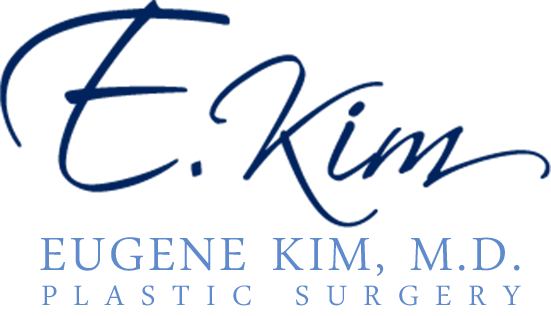 After breast augmentation, most patients enjoy beautiful, natural-looking results. However, in some cases, complications can affect the position or shape of the implants. Two of the most commonly confused issues are the “double bubble” deformity and “bottoming out.” Although they can look similar, these complications have very different causes and treatments. Board certified plastic surgeon Dr. Eugene Kim provides breast augmentation and breast revision to patients in Beverly Hills, Los Angeles, Santa Monica, West Hollywood, CA, and surrounding communities.
After breast augmentation, most patients enjoy beautiful, natural-looking results. However, in some cases, complications can affect the position or shape of the implants. Two of the most commonly confused issues are the “double bubble” deformity and “bottoming out.” Although they can look similar, these complications have very different causes and treatments. Board certified plastic surgeon Dr. Eugene Kim provides breast augmentation and breast revision to patients in Beverly Hills, Los Angeles, Santa Monica, West Hollywood, CA, and surrounding communities.
Understanding Implant Position Complications
Implant placement and tissue support are crucial for maintaining long-term breast shape. When the implant or surrounding tissues shift, stretch, or scar unevenly, it can lead to visible folds, ripples, or misplaced implants. Both double bubble and bottoming out involve the implant dropping or sitting incorrectly—but the underlying mechanisms are distinct.
What Is a Double Bubble?
A double bubble occurs when a visible crease or line forms across the lower breast, creating the appearance of two separate folds or contours. Essentially, it looks like there’s a smaller breast sitting on top of another curve.
Causes of Double Bubble:
-
The implant sits too low, creating a new crease below the natural fold.
-
The surgeon fails to fully release the inframammary fold (IMF) during surgery.
-
The implant drops beneath the natural breast tissue, while the original fold remains visible.
-
Anatomical factors like tight lower breast skin or a high natural fold can increase risk.
-
It can also occur after breastfeeding or weight fluctuations, as natural tissue changes over time.
How It Looks: -
A horizontal crease across the lower pole
-
The breast appears divided into two parts
-
The lower half looks overly round or distorted
Treatment Options:
Correcting a double bubble often involves revision surgery to adjust the implant pocket or release the fold. Techniques include repositioning the implant higher in the breast pocket, recreating or reinforcing the natural fold with sutures, switching from submuscular to subglandular placement (or vice versa), or in some cases removing and replacing the implant entirely.
What Is Bottoming Out?
Bottoming out happens when the implant descends too far down the chest, stretching the skin and moving the nipple upward relative to the implant. The implant essentially slides below its intended position.
Causes of Bottoming Out:
-
Over-dissection or overly large implant pocket
-
Weak lower-pole tissue or poor support structure
-
Heavier or larger implants
-
Gravity and long-term tissue stretching
-
Multiple pregnancies or weight changes that weaken skin elasticity
How It Looks: -
Nipples appear too high or point slightly upward
-
The lower breast becomes overly full and rounded
-
The upper breast looks flat
-
The lower fold appears lower than before
Treatment Options:
Bottoming out can be corrected with capsulorrhaphy, a surgical technique that tightens the implant pocket. The surgeon may also reinforce the fold with internal sutures or mesh, adjust implant size or placement plane, replace implants with lighter options, or combine with a breast lift if tissue laxity is significant.
Key Differences Between Double Bubble and Bottoming Out
| Feature | Double Bubble | Bottoming Out |
|---|---|---|
| Cause | Implant drops below natural fold or fold not released | Implant slides too low due to weak tissue or large pocket |
| Appearance | Two visible folds or curves on lower breast | Nipple appears high, breast too full at bottom |
| Location of Problem | Implant and fold relationship | Implant position relative to chest wall |
| Treatment | Adjust or recreate fold, reposition implant | Tighten pocket, reinforce tissue support |
Preventing Implant Malposition
-
Choose an experienced, board-certified plastic surgeon who understands breast anatomy.
-
Select implant sizes and profiles that suit your tissue characteristics.
-
Follow post-op care instructions, including support bra use.
-
Avoid heavy lifting or pressure on the chest during early recovery.
The Takeaway
While double bubble and bottoming out can look similar, their causes and solutions are very different. Both can be corrected safely with revision surgery when performed by an experienced surgeon. If you notice unusual folds, asymmetry, or changes in implant position, it’s important to schedule an evaluation early—prompt correction leads to better results and peace of mind.
Contact the Office of Beverly Hills Plastic Surgeon Dr. Eugene Kim
Click here see more plastic surgery procedures and treatments performed by Board Certified Plastic Surgeon, Dr. Eugene Kim on patients in Beverly Hills, Los Angeles, West Hollywood, Santa Monica, CA and surrounding areas or call 310-271-6996 to schedule a consultation.
